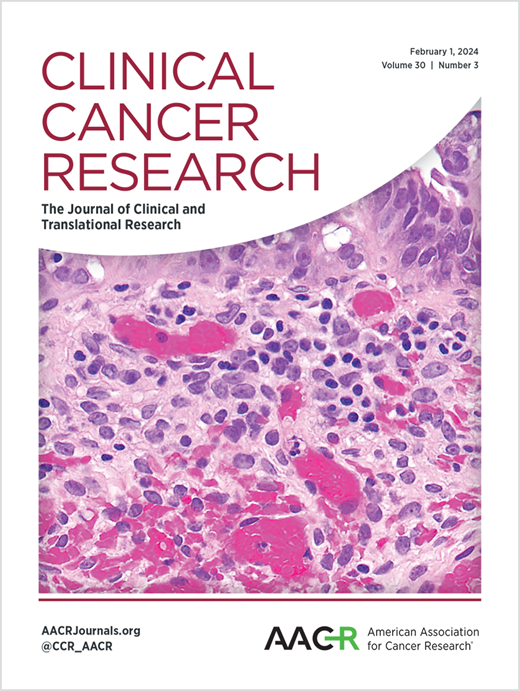Early Postoperative Minimal Residual Disease Detection with MAESTRO Is Associated with Recurrence and Worse Survival in Patients with Head and Neck Cancer
IF 10
1区 医学
Q1 ONCOLOGY
引用次数: 0
Abstract
Purpose: Although ctDNA is a promising biomarker for minimal residual disease (MRD) detection in head and neck squamous cell carcinoma (HNSCC), more sensitive assays are needed for accurate MRD detection at clinically relevant time points. Ultrasensitive MRD detection early after surgery could guide adjuvant therapy decisions, but early ctDNA dynamics are poorly understood. Experimental Design: We applied minor allele–enriched sequencing through recognition oligonucleotides (MAESTRO), a whole-genome, tumor-informed, mutation enrichment sequencing assay, in a pooled testing format called MAESTRO-Pool, to plasma samples from patients with HNSCC collected shortly after surgery and during surveillance. We evaluated whether early MRD detection could predict outcomes. Results: Among 24 patients with predominantly human papillomavirus–independent (95.8%) HNSCC, rapid ctDNA clearance occurred by the first postoperative sample (1–3 days postoperatively) in nine patients without an event (recurrence or death). Thirteen of fifteen patients with an event were MRD-positive (positive predictive value = 92.9%; negative predictive value = 80%) with a median tumor fraction (TFx) of 54 parts per million (ppm; range 6–1,177 ppm). In the first and last samples of the early postoperative window, 8/13 and 10/13 patients, respectively, had TFx below 100 ppm, the detection limit of leading commercial assays. Early MRD detection correlated with worse overall survival (HR, 8.3; 95% confidence interval, 1.1–66.1; P = 0.02) and event-free survival (HR, 27.4; 95% confidence interval, 3.5–214.5; P < 0.0001) independent of high-risk pathology. Conclusions: Early postoperative MRD detection by MAESTRO was associated with recurrence and worse survival. Given the ultralow TFxs observed, ultrasensitive assays will be essential for reliable MRD detection during early postoperative time points to enable personalized adjuvant therapy decision-making in HNSCC. See related article by Bryan et al., p. XX .MAESTRO术后早期微小残留病变检测与头颈癌患者的复发和更差的生存率相关
目的:虽然ctDNA是头颈部鳞状细胞癌(HNSCC)微小残留病(MRD)检测的一种有希望的生物标志物,但在临床相关时间点,需要更灵敏的检测方法来准确检测MRD。术后早期的超灵敏MRD检测可以指导辅助治疗决策,但早期ctDNA动态尚不清楚。实验设计:我们通过识别寡核苷酸(MAESTRO)进行少量等位基因富集测序,这是一种全基因组、肿瘤信息、突变富集测序测定,采用一种称为MAESTRO- pool的合并检测格式,对HNSCC患者术后和监测期间收集的血浆样本进行测序。我们评估了早期MRD检测是否可以预测预后。结果:在24例主要不依赖人乳头瘤病毒(95.8%)的HNSCC患者中,9例患者在术后第一个样本(术后1-3天)发生快速ctDNA清除,无事件(复发或死亡)。15例发生事件的患者中有13例mrd阳性(阳性预测值= 92.9%;阴性预测值= 80%),中位肿瘤分数(TFx)为百万分之54 (ppm);范围6 - 1177 ppm)。在术后早期窗口的第一个和最后一个样本中,分别有8/13和10/13例患者的TFx低于100ppm,这是领先的商业测定法的检测限。早期MRD检测与较差的总生存相关(HR, 8.3;95%置信区间为1.1-66.1;P = 0.02)和无事件生存率(HR, 27.4;95%置信区间为3.5 ~ 214.5;P, lt;0.0001),与高危病理无关。结论:MAESTRO术后早期MRD检测与复发和较差的生存率相关。鉴于观察到的超低tfx,超灵敏的检测对于在术后早期可靠的MRD检测至关重要,从而使HNSCC的个性化辅助治疗决策成为可能。参见Bryan等人的相关文章,第XX页。
本文章由计算机程序翻译,如有差异,请以英文原文为准。
求助全文
约1分钟内获得全文
求助全文
来源期刊

Clinical Cancer Research
医学-肿瘤学
CiteScore
20.10
自引率
1.70%
发文量
1207
审稿时长
2.1 months
期刊介绍:
Clinical Cancer Research is a journal focusing on groundbreaking research in cancer, specifically in the areas where the laboratory and the clinic intersect. Our primary interest lies in clinical trials that investigate novel treatments, accompanied by research on pharmacology, molecular alterations, and biomarkers that can predict response or resistance to these treatments. Furthermore, we prioritize laboratory and animal studies that explore new drugs and targeted agents with the potential to advance to clinical trials. We also encourage research on targetable mechanisms of cancer development, progression, and metastasis.
 求助内容:
求助内容: 应助结果提醒方式:
应助结果提醒方式:


